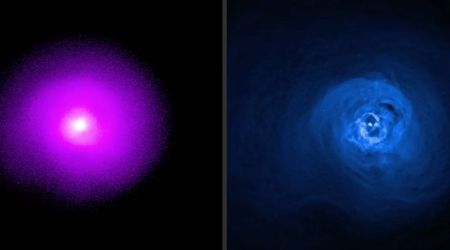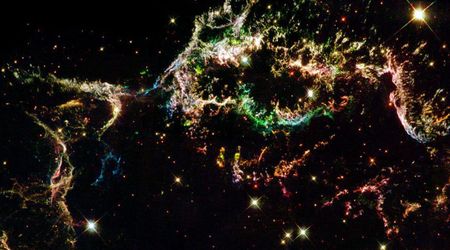Astronomers uncover the most distant 'mini-halo' that holds secrets to the universe's birth

An international research team has unveiled the most distant "mini-halo" of energetic particles ever observed, providing striking insight into the early universe. Utilizing the advanced Low Frequency Array (LOFAR) radio telescope, scientists detected this massive cloud of high-energy particles surrounding a galaxy cluster so remote that its light has traveled for 10 billion years to reach Earth, effectively doubling the previous distance record for such a discovery, according to Astron.

These groundbreaking findings indicate that even the universe's largest structures, galaxy clusters, have been permeated by high-energy particles for a significant portion of their existence. Mini-halos are characterized by highly energetic charged particles residing in the vast vacuum between galaxies within a cluster, emitting detectable radio waves. This discovery strongly suggests that energetic processes were actively shaping galaxy clusters during the universe's nascent stages.

The research was co-led by Dr. Julie Hlavacek-Larrondo of the Université de Montréal in Canada and Dr Roland Timmerman of Durham University, UK. Their team analyzed data from the LOFAR radio telescope, a sprawling network comprising over 100,000 small antennas across eight European nations. During their examination of the galaxy cluster SpARCS1049, researchers identified a subtle, diffuse radio signal. Further investigation revealed the signal originated not from individual galaxies, but from an expansive region of space, over a million light-years across, rich in high-energy particles and magnetic fields, as per Phys.org.

This diffuse emission is a definitive signature of a mini-halo, a phenomenon previously only observed in closer celestial objects. "We’ve discovered a vast cosmic ocean, where entire galaxy clusters are constantly immersed in high-energy particles,” stated Dr. Hlavacek-Larrondo. Dr Roland Timmerman expressed astonishment at the signal's strength from such a distance. "It means these energetic particles and the processes creating them have been shaping galaxy clusters for nearly the entire history of the Universe,” he remarked.

Scientists are exploring two primary hypotheses for mini-halo formation. One theory points to supermassive black holes at the core of cluster galaxies, which can expel high-energy particle streams into space. However, the precise mechanism by which these particles migrate so far from the black hole while retaining significant energy remains an active area of research. The second explanation centers on cosmic particle collisions. This involves charged particles within the hot plasma of a galaxy cluster colliding at near-light speeds, fragmenting into the high-energy particles observed. This new data offers a unique glimpse into the state of galaxy clusters shortly after their formation.

This discovery not only extends the known timeline of high-energy particle infusion in galaxy clusters by billions of years but also offers critical insights into the origins of these particles. It suggests that black holes and/or high-energy particle collisions have been enriching galaxy cluster environments much earlier than previously thought, sustaining their energy over eons, as mentioned in Astron.
Further telescopic endeavors, such as the Square Kilometer Array (SKA), are anticipated to detect even fainter signals, further advancing our understanding of magnetic fields, cosmic rays, and the energetic forces that mold the universe. “We are just scratching the surface of how energetic the early Universe really was," Dr. Hlavacek-Larrondo concluded, “This discovery gives us a new window into how galaxy clusters grow and evolve, driven by both black holes and high-energy particle physics.”









